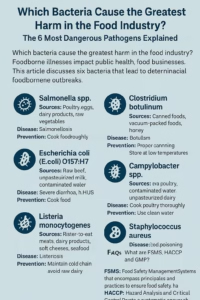Introduction
Learn more about Food Safety Management Systems (FSMS) and their role in food safety.
Which Bacteria Cause the Greatest Harm in the Food Industry?

- Salmonella spp.
Sources: Poultry, eggs, dairy products, raw vegetables, and contaminated water.
Disease: It causes salmonellosis, which causes symptoms such as diarrhea, fever, and vomiting. According to the Centers for Disease Control and Prevention (CDC), in the U.S. alone, about 1.35 million infections, 26,500 hospitalizations, and 420 deaths occur each year from Salmonella.
How the disease occurs: When the bacteria enter the stomach, it invades intestinal cells, causing inflammation and infection.
Prevention: Cook food well, avoid cross-contamination, and maintain hygiene during food handling.
Explore How to Implement HACCP in Food Processing
- Escherichia coli (E. coli) O157:H7
Sources: Raw beef, unpasteurized milk, contaminated water, and raw produce.
Disease: It causes severe diarrhea and Hemolytic Uremic Syndrome (HUS), which can lead to kidney failure. According to the CDC, there are about 265,000 cases in the U.S. each year.
How the disease occurs: It produces Shiga toxin, which damages the blood vessels of the intestines and kidneys.
Prevention: Cook food thoroughly, wash your hands thoroughly, and avoid cross-contamination. - Listeria monocytogenes
Sources: Ready-to-eat meats, dairy products, soft cheeses, and seafood.
Disease: It causes listeriosis, which is very dangerous for pregnant women, newborns, and elderly people. According to the FDA, there are about 1,600 cases in the U.S. each year, with a fatality rate of 20-30%.
How the disease spreads: It can survive in refrigeration and invades host cells, causing severe infections.
Prevention: Maintain cold chain management, proper sanitation, and avoid raw dairy consumption. - Clostridium botulinum
Sources: Improperly canned foods, vacuum-packed products, and honey.
Disease: It produces botulinum toxin, which causes botulism, which can cause paralysis and can be fatal.
How does the disease occur: This neurotoxin blocks nerve signals, which can cause respiratory failure.
Prevention: Practice food preservation correctly, store at low temperatures, and avoid expired canned goods. - Campylobacter spp.
Sources: Raw poultry, contaminated water, and unpasteurized dairy.
Disease: It causes campylobacteriosis, which causes fever, abdominal cramps, and diarrhea. According to the CDC, the U.S. There are about 1.5 million cases per year in the U.S.
How the disease occurs: It attacks the intestinal lining, causing inflammation and diarrhea.
Prevention: Cook poultry at safe temperatures, maintain hygiene, and use clean water - Staphylococcus aureus
Sources: Dairy, meat, and bakery products if not handled properly.
Disease: It produces enterotoxins, causing food poisoning, causing nausea, vomiting, and diarrhea.
How the disease occurs: This toxin triggers inflammation and fluid loss.
Prevention: Practice correct food handling, avoid temperature abuse, and maintain personal hygiene.
Prevention & Control Measures
![]()
1.Implement HACCP & GMP
- HACCP (Hazard Analysis and Critical Control Points): This is a systematic approach that identifies critical points where contamination may occur and establishes preventive controls.
- GMP (Good Manufacturing Practices): These are guidelines that ensure that food is produced in a hygienic and safe environment.
- Regulatory Compliance: Organizations such as FSSAI (India), FDA (U.S.), and EFSA (Europe) mandate HACCP-based food safety programs.
2.Microbiological Testing
- Regularly test food products for bacterial contamination, which will help in early detection and preventing outbreaks.
3.Proper Food Storage & Handling
- Cold Storage: Maintain refrigeration at ≤5°C (41°F) and freezing at ≤-18°C (0°F).
- Cooking Temperatures: Poultry ≥74°C (165°F), beef ≥63°C (145°F), and seafood ≥62°C (145°F).
4.Employee Hygiene Training
- Training food handlers on hygiene and safety practices is very important to prevent contamination.
- Wash hands with soap for at least 20 seconds to reduce bacterial transmission
FAQs
Q1: Which Bacteria Cause the Greatest Harm in the Food Industry?
The six most harmful bacteria in the food industry are Salmonella, E. coli O157:H7, Listeria monocytogenes, Clostridium botulinum, Campylobacter, and Staphylococcus aureus.
Q2: How can I prevent bacterial contamination in food?
Follow HACCP guidelines, proper hygiene, safe cooking temperatures, and microbiological testing.
Q3: What temperature kills harmful bacteria in food?
Cooking at ≥74°C (165°F) for poultry and ≥63°C (145°F) for beef kills most bacteria.
Q4: Which bacteria can survive refrigeration?
Listeria monocytogenes can grow in refrigerated conditions, making it particularly dangerous.
Q5: What is the best way to ensure food safety at home?
- Wash hands frequently.
- Keep raw and cooked foods separate.
- Store perishable foods at safe temperatures.
- Cook food thoroughly.
Conclusion
Understanding which bacteria cause the greatest harm in the food industry is crucial for maintaining food safety. Bacterial contamination is a huge health and financial risk in the food industry. It is very important to implement robust Food Safety Management Systems (FSMS) and follow regulatory standards like FSSAI, FDA, and WHO guidelines.
📢 What do you think?
you like our article about Which Bacteria Cause the Greatest Harm in the Food Industry
Which food safety practices do you follow in your home or workplace? Let us know in the comments! ✅
References & Further Reading:
- World Health Organization (WHO): https://www.who.int/news-room/fact-sheets/detail/food-safety
- Centers for Disease Control and Prevention (CDC): https://www.cdc.gov/foodsafety/
- Food and Drug Administration (FDA): https://www.fda.gov/food
- European Food Safety Authority (EFSA): https://www.efsa.europa.eu/en/topics/topic/foodborne-diseases
